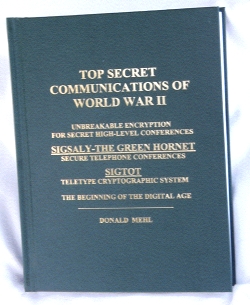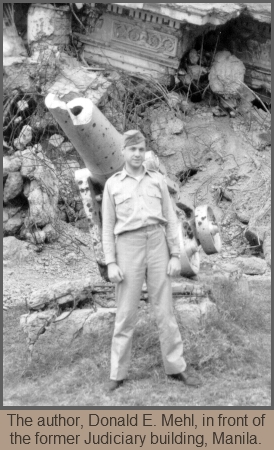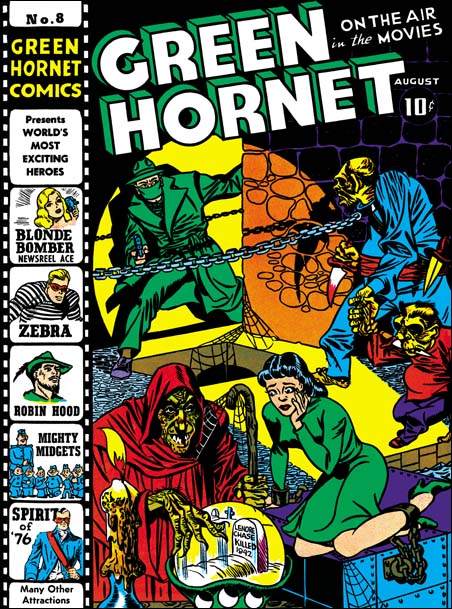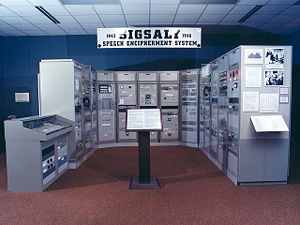This review reproduced from and originally published in CRYPTOLOGIA
magazine.
Author: Dr. Louis Kruh, Editor. Minor editorial changes have been made to
bring its content current.

AMERICA'S WORLD WAR II
UNBREAKABLE CODE
FOR SECRET TELEPHONY
THE U. S. SIGNAL CORPS' SIGSALY SYSTEM
 One
of the closest guarded secrets of World War II was the cloak and dagger
communications system known in the Signal Corps as Sigsaly and nicknamed The
Green Hornet after a popular radio program of the day that used a similar
sounding buzz in the introduction to its radio program. Bell Laboratories
and the Army General Staff called it the "X" system.
One
of the closest guarded secrets of World War II was the cloak and dagger
communications system known in the Signal Corps as Sigsaly and nicknamed The
Green Hornet after a popular radio program of the day that used a similar
sounding buzz in the introduction to its radio program. Bell Laboratories
and the Army General Staff called it the "X" system.
The reason for the secrecy was that it used a new digital technology that
made it absolutely unbreakable by an enemy. Therefore, it was used by the
highest levels of military and civilian officials for strategic and tactical
conferences between Washington and all of the theaters of war. It was
installed and operated by the 805th Signal Service Company.
The details of Sigsaly were kept secret until they were released under the
Freedom of Information Act in 1975. With the release of the Bell
Laboratories' patents and other information through the years, its
contributions to the war effort and technology became known. Now, the entire
story of this vital wartime facility is told in its entirety from its
inception to its final decommissioning in a book called
TOP SECRET COMMUNICATIONS OF WORLD WAR II, by Donald Mehl, a graduate of the
Army Signal Corps OCS Class 44-35.
This book tells the story of the development, implementation, and operation
of this secret telephone system and also the events surrounding the uses of
the system. The story is told in the context of World War II and illustrates
the impact that Sigsaly had on the major campaigns of that War. The Bell
Telephone Laboratories, the Army General Staff and the Signal Corps brought
this system to fruition and provided secure voice communications worldwide
for U. S. military and civilian leaders.
In early meetings between President Roosevelt and Prime Minister Churchill,
they expressed a need for better communications between Washington and
London; they knew that the commercial overseas telephone system lacked
security. In fact the Germans were monitoring it and sending transcripts to
Hitler. When the opportunity came to obtain an absolutely secure
radiotelephone system, namely, the Green Hornet, General George Marshall
gave the project his approval and a high priority.
 The
Green Hornet signal was designed so that conversations could be carried on
between distant points with complete secrecy. The transmitted information
was so enciphered as to produce security against decoding in case of
interception of the transmitted signals by someone not in possession of the
cipher key. This means that even if someone had a duplicate set of equipment
they could not decipher the signals. In fact, the Germans did intercept the
radio signals but did not even recognize them as voice signals.
The
Green Hornet signal was designed so that conversations could be carried on
between distant points with complete secrecy. The transmitted information
was so enciphered as to produce security against decoding in case of
interception of the transmitted signals by someone not in possession of the
cipher key. This means that even if someone had a duplicate set of equipment
they could not decipher the signals. In fact, the Germans did intercept the
radio signals but did not even recognize them as voice signals.
The method of encoding consisted of an analytical breakdown of the speech
energy into frequency bands from which control currents proportional to the
energy in each band or channel were set up. These control or energy-defining
currents were digitally coded, properly combined and then transmitted to the
distant receiving end. At the receiving end, the energy was again divided
into the component channels and the proper key applied to each. The
resultant control currents actuated a synthetic voice source from which the
original speech was reconstructed. Pitch as well as sibilance and the
syllabic sounds of the voice were determined and included in the signal. The
coding and decoding was done digitally using one-time records.
From the fighting in Africa to the Japanese surrender in Tokyo Bay, Sigsaly
was present with every U. S. Army Theater headquarters. Over 3,000 top
secret telephone conferences were held using Sigsaly. The buzz of the Green
Hornet carried these conferences from the Pentagon in Washington D. C. to
the overseas theater headquarters of the U. S. Army and Navy. U. S. leaders,
military and civilian, were able to discuss the problems of war with
absolute security. These daily conferences were solving the detailed
problems that made possible the winning of the war.
Its development opened the way for the digital revolution since it was the
first voice product ever manufactured that used digital techniques. The
term digital was not used at that time. The technique was then known as
pulse transmission; therefore, Sigsaly was credited with being the first
pulse code modulation (PCM) equipment ever manufactured. Later, most
telecommunications systems used this technique.
 Many
men and women were involved in the invention, procurement, deployment and
operation of the Sigsaly system. Many more made use of the system to
prosecute the war. Development engineers at Bell Telephone Laboratories
eventually received 32 patents for their inventions. Western Electric
Company built the equipment in record time. Instructors at The Bell
Laboratories School for War Training taught this advanced electronic
technology to the military students. The U. S. Army General Staff worked to
approve, procure and implement the system in record time while imposing the
tightest security possible to prevent its being compromised. The Signal
Corps recruited and organized the skilled people who would install and
operate the system around the world.
Many
men and women were involved in the invention, procurement, deployment and
operation of the Sigsaly system. Many more made use of the system to
prosecute the war. Development engineers at Bell Telephone Laboratories
eventually received 32 patents for their inventions. Western Electric
Company built the equipment in record time. Instructors at The Bell
Laboratories School for War Training taught this advanced electronic
technology to the military students. The U. S. Army General Staff worked to
approve, procure and implement the system in record time while imposing the
tightest security possible to prevent its being compromised. The Signal
Corps recruited and organized the skilled people who would install and
operate the system around the world.
Everyone involved was required to maintain the secrecy of the system, even
in civilian life, for three decades after the war ended. They could not
answer the question, “what did you do in World War II.” Now, thanks to
declassification and this book, the whole story can be told. The
book was written by a former member of the 805th Signal Service Co.
- - - - -
Additional Notes & Clarifications By The Author,
Donald E. Mehl
[Editor's Note: As of the date of
this publication, June 2012, Don Mehl was approaching his 90th birthday.]
The book principally describes the two cryptographic
systems used for high-level top secret conferencing during World War II by
the General Staff in communicating with overseas theater commanders. It was
also used by high level government officials such as the President and his
cabinet for communications with their counterparts in other countries.
The SIGSALY system provided totally secure telephone
conferencing facilities and the SIGTOT system provided equally totally
secure instantaneous teletype communications for conferencing and the
transmission of top secret information. Descriptions of other widely used
encryption systems are also included in the book such as the SIGABA and
M-209. A description and comparison is made with German cryptographic
systems such as the ENIGMA and Lorenz. The existence and use of SIGSALY was
a closely guarded secret.
Unbeknownst to many, it was a huge system. A total
system could weigh up to 50 tons. It required approximately 2,000 square
feet of floor space. Members of the 805th Signal Service Company, who
operated the system, had to keep these secrets for many years even after the
end of the war. Only those who had a need to know had knowledge of the
system. While General Marshall knew of the system, he did not have clearance
for the technical detail of the system because, of course, he had no need to
have this knowledge. Initially only certain people could use the system and
there was an official a list of those who were authorized.
 SIGSALY
operated from July 1943 until mid-1946 when it closed down and all of the
outlying terminals were returned to the Army Security Agency. The technology
of SIGSALY remained a secret until 1976 when Bell Laboratories, who designed
the system and held many of its patents, had it declassified under the
Freedom of Information Act. Many of the patents covered digital techniques
that Bell Labs used in their development of digital communications. SIGSALY
is known as the “Beginning of the Digital Age” and was the first digital
voice product ever manufactured.
SIGSALY
operated from July 1943 until mid-1946 when it closed down and all of the
outlying terminals were returned to the Army Security Agency. The technology
of SIGSALY remained a secret until 1976 when Bell Laboratories, who designed
the system and held many of its patents, had it declassified under the
Freedom of Information Act. Many of the patents covered digital techniques
that Bell Labs used in their development of digital communications. SIGSALY
is known as the “Beginning of the Digital Age” and was the first digital
voice product ever manufactured.
SIGTOT was used until 1959. Until then there was not a
substitute for totally secure Teletype communications with one-time
encryption without repetition. The 805th operated SIGTOT in the Pentagon and
other locations; however, since it only required the addition of the 131B-2
Encryption Table to a standard Teletype installation it was possible to
install SIGTOT in other places such as the White House. The key used was a
perforated tape that was provided for each end of a communications
circuit. This was a symmetrical system which limited it to high-level use
because identical tapes would have to be produced for each end of every
circuit. The technology and equipment for the SIGTOT system is described and
illustrated in this book. When seeking background information for the book I
found that the NSA did not have information about SIGTOT because everything
had been destroyed. However, I was able to obtain an instruction book from
the grandson of the inventor of the Teletype machine who kept an instruction
book on everything that he had made. All of this information is in the book.
The SIGSALY system was installed and operated by the
805th Signal Service Company. The 805th was a most unique army
organization. Its table of organization provided for 85 officers and 200
enlisted men. Why so many officers? The 805th operate 12 terminals 24 hours
a day seven days a week at all of the theater
headquarters around the world. Two terminals were in the Pentagon, one for
Europe and one for the Pacific. The other ten terminals were operated by
detachments of the 805th around the world, each with one Captain and four
Lieutenants. One Officer had to be on duty each shift as the cryptographic
officer, plus other Officers for headquarters and other duties. Fifteen
enlisted men performed maintenance functions and other duties.
- - - - -
Credits & Notes:
Text above reproduced with minor
editorial changes in order to bring it current. Editorial changes by the
Managing Editor, ArmySignalOCS.com. Original text from Cryptologia
magazine, as written by Dr. Louis Kruh, Editor.
The book's title is: TOP SECRET COMMUNICATIONS OF WORLD WAR II. It
is hard cover and contains 201 8X10 inch pages, over 100,000 words and
includes many pictures and illustrations. It can be purchased on this
website on the PX page.
Payment is tax deductable as profits from the book are donated to this
website's scholarship charity. Those wishing to communicate directly
with the Author, Donald E. Mehl, may send eMails to the Webmaster of this
website. They will be forwarded to Mr. Mehl for his consideration in reply.
Thank you.

